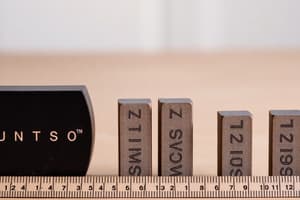Podcast
Questions and Answers
मापन के लिए आधारभूत इकाई 'किलोग्राम (kg)' का मापन क्या है?
मापन के लिए आधारभूत इकाई 'किलोग्राम (kg)' का मापन क्या है?
- प्रकाश की तीव्रता का मापन
- प्लैटिनम-आयरिडियम आयाम का मापन (correct)
- समय का मापन
- मात्रा का मापन
मापन के लिए आधारभूत इकाई कौन सी है?
मापन के लिए आधारभूत इकाई कौन सी है?
- मीटर (m) (correct)
- एम्पीयर (A)
- किलोग्राम (kg)
- सेकंड (s)
अंतर्राष्ट्रीय मानक प्रक्रिया (SI) के अनुसार, समय की मानक इकाई क्या है?
अंतर्राष्ट्रीय मानक प्रक्रिया (SI) के अनुसार, समय की मानक इकाई क्या है?
- किलोग्राम (kg)
- केल्विन (K)
- मीटर (m)
- सेकंड (s) (correct)
'मीटर' की सीमा से छोटा मापन 'सेंटीमीटर' (cm) से क्या कहलाता है?
'मीटर' की सीमा से छोटा मापन 'सेंटीमीटर' (cm) से क्या कहलाता है?
प्रमुख मात्रा प्रमाणों में से 'केल्विन (K)' का संकेतक क्या है?
प्रमुख मात्रा प्रमाणों में से 'केल्विन (K)' का संकेतक क्या है?
समय की मात्रक इकाई के रूप में कौन-सा है?
समय की मात्रक इकाई के रूप में कौन-सा है?
विद्युत प्रवाह की मापन के लिए कौन-सी मात्रक इकाई है?
विद्युत प्रवाह की मापन के लिए कौन-सी मात्रक इकाई है?
केल्विन स्केल का उपयोग करने का प्रमुख उद्देश्य क्या है?
केल्विन स्केल का उपयोग करने का प्रमुख उद्देश्य क्या है?
कंडेला (cd) संकेतक किसे संतुलित करने के लिए प्रयोग होता है?
कंडेला (cd) संकेतक किसे संतुलित करने के लिए प्रयोग होता है?
सतता की मात्रा का मूल्यांकन करने के लिए कौन-सी मात्रक इकाई प्रयोग होती है?
सतता की मात्रा का मूल्यांकन करने के लिए कौन-सी मात्रक इकाई प्रयोग होती है?
Flashcards
SI Units
SI Units
Globally accepted system with seven base units for specific quantities.
Length
Length
Physical distance between two points, measured in meters (m).
Mass
Mass
Measure of the amount of matter in an object, measured in kilograms (kg).
Time
Time
Signup and view all the flashcards
Electric Current
Electric Current
Signup and view all the flashcards
Temperature
Temperature
Signup and view all the flashcards
Luminous Intensity
Luminous Intensity
Signup and view all the flashcards
Amount of Substance
Amount of Substance
Signup and view all the flashcards
Prefixes (Units)
Prefixes (Units)
Signup and view all the flashcards
Conversion Factors
Conversion Factors
Signup and view all the flashcards
Study Notes
Unlocking the Mystery: A Comprehensive Guide to Physics and Unit Measurements
On this thrilling journey through the world of physics, we shall delve into the captivating subtopic of unit and measurements. Physics is the foundation of our understanding of the natural world, providing us with a deeper insight into the building blocks of our universe. Let's explore this realm together by examining the fundamental principles and vital measurements that underpin physics.
Unit Systems
While there are several unit systems in use today, we are primarily concerned with the International System of Units (SI), which was formulated by the International Organization for Standardization (ISO). This system has become globally accepted and features seven key units for specific quantities:
- Length: Meter (m)
- Mass: Kilogram (kg)
- Time: Second (s)
- Electric Current: Ampere (A)
- Temperature: Kelvin (K)
- Luminous Intensity: Candela (cd)
- Amount of Substance: Mole (mol)
Length
Length is probably the most familiar unit in our daily lives. It represents the physical distance between two points. The meter is the fundamental unit of length, and it can be further divided into centimeters (cm) and millimeters (mm).
Mass
Mass is a measure of the amount of matter within an object. The kilogram (kg) is the fundamental unit of mass, and it's typically defined as the mass of a platinum-iridium alloy prototype kept in France.
Time
Time is the aspect that dictates the progression of events in our universe. The second is the fundamental unit of time, and it's defined as the duration of 9,192,631,770 periods of the radiation corresponding to the transition between the two hyperfine levels of the ground state of cesium-133 atom.
Electric Current
Electric current is the flow of electric charge, and the ampere (A) is the unit of measurement. It is named after André-Marie Ampère, a French mathematician and physicist whose work on electromagnetism was groundbreaking.
Temperature
Temperature refers to the degree of hotness or coldness of an object. The Kelvin scale is used for temperature measurements in physics. Unlike the Celsius scale, which employs degree Celsius (°C), the Kelvin scale uses degree Kelvin (K), and 0 Kelvin indicates absolute zero, which is the lowest possible temperature.
Luminous Intensity
Luminous intensity refers to the amount of light emitted by a source. The candela (cd) is the unit used to measure this quantity. It's named after the Greek word kandela, which refers to a candle.
Amount of Substance
The amount of substance is a measure of the number of particles of a particular substance. The mole (mol) is the fundamental unit used to express the quantity of a substance.
Conversions and Prefixes
In addition to the seven key units, we can also express quantities using prefixes, which modify the base units to represent smaller or larger quantities. For instance, the prefix "milli" (m) is used to represent one-thousandth of a unit, while "kilo" (k) is used to represent one thousand times a unit.
To convert between units, it's essential to know the conversion factors. For instance, the length conversion factor between centimeters (cm) and meters (m) is 100 cm = 1 m.
Conclusion
Physics is a vast and exciting field that offers us an unparalleled glimpse into the inner workings of our universe. Understanding the fundamental unit and measurement systems that underpin physics is crucial to comprehending the principles and formulas that drive our world. With this knowledge, we can marvel at the intricacies of a subatomic particle or the beauty of cosmic phenomena. So, let's continue exploring this fascinating realm together!
Studying That Suits You
Use AI to generate personalized quizzes and flashcards to suit your learning preferences.




